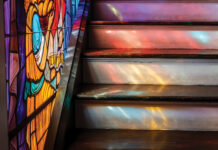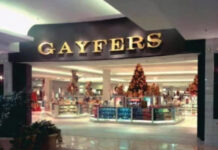


It’s a cloudy Saturday morning at Fairhope’s Secret Beach. The air is clear and sweet from the previous night’s rain. A heavy fog bank roils along the tree line and blurs the western horizon, blending both the Bay and the sky into one infinite depth.
Ben Gibson and his two young sons are here to hunt for treasure. Gibson often comes down to this quiet sandy stretch most weekends to soak up the seclusion, but today is an especially good day because conditions are perfect for a treasure-hunting expedition.
Earlier in the week, a thunderous gullywasher swept across the Bay, dumping torrents of water that sluiced down the muddy folds of Fairhope’s shoreline, shifting and molding the layers of clay and soil. The Gibsons are experienced enough to know that this is the kind of storm that unearths old glass bottles and other artifacts from Fairhope’s past. Equipped with rain boots and a five-gallon bucket, Ben and his boys set off to see what they can find.
To arrive at the Secret Beach, they’ve come down the “Stairway to Heaven,” a 76-step wooden public access stairway hidden in the trees near an infrequently traveled road. There’s no public parking, no city signs to point the way, which means you’ll never find it if you don’t know where it is.
Ben only knows about it because, back in his early 20s, he used to live up on this part of the bluff, in a crummy cinderblock house with a great view.
Once they’ve made it down the rain-slick steps, traversed a short trail and emerged onto the beach, Ben and his sons – fifth-grader Rett and second-grader Davis – scan the sand for flotsam and jetsam that has washed ashore. They collect trash to throw away later and put anything that looks interesting into the bucket. Their finds are the usual beachcomber stuff: bits of sea glass, plastic knickknacks, driftwood. But these are just smaller treasures, curiosities to gather on their way to the main attraction. Their destination is halfway up the beach, invisible until you’re right up on it. There, behind a curtain of vegetation, an invitingly clear path of tumbledown rocks, silt and clay recedes into the bluff.

Into the Thicket
Less intrepid beachgoers might be inclined to leave this gully to the snakes and raccoons. But the Gibsons delve into the gloom without a moment’s hesitation, ready to clamber over logs and duck under branches. Not 30 feet from the start of the path, a jumble of rusted car frames lies within reach.
It’s not long before they find what they came for, half-hidden in the damp dirt: A glass medicine bottle. A little white porcelain jar. A whiskey bottle. Improbably, a new-looking beach ball, still inflated. Whenever they find an artifact, they check it for markings that could help to date it. In the two years they’ve been exploring this gully, they’ve found more than 200 bottles, including a couple that date back 100 years.
Ben reckons that this gully used to be the place to dump trash for the people who lived up on the bluff. “All the people who lived in this neighborhood were coming down here at some point and just throwing out trash,” he said. “Eventually it gets washed out. It’s still washing out, 100 years later, into the Bay.”
As it turns out, lots of early Fairhopers saw gullies as convenient places to chuck their garbage. Sometimes these dumps were informal, but in the early years of the 20th century, Big Mouth Gully on the northern outskirts of downtown was home to a city-sanctioned dump. A gossipy article from the April 18, 1924, edition of the Fairhope Courier reads:
“One of our new citizens was mildly scolded by a ‘father of the town’ the other day, for dumping some trash into the gulley… The gentleman in question is as deeply interested in preserving the attractiveness of Fairhope as any one and explained that seeing other matter having been dumped there, he thought it might be a recognized dumping place, for the purpose of helping to fill up the gulley. On having it explained to him that there was only one authorized dumping place which was down Section street opposite the cemetery, he urged the Courier to call attention to this fact, so that others might be spared the mistake which he had made.”
Stack Gully near the Fairhope Pier has also claimed artifacts, including whole cars that still lie buried under the kudzu. A century ago, when Klumpp Motor Company stood on the gully’s edge, a few “early junkers” somehow ended up tumbling into the depths below, according to local historian Alan Samry in his book “Fairhope (Past and Present).”

Gatherings and Tire Swings
The gully at the Secret Beach is not grand enough to have a name on the map, but it’s the most prolific source of artifacts that Ben has found. Within half an hour, the Gibsons have exhausted the area and emerged from the undergrowth. The sun has started to peep out from behind the clouds. Nearby, a little ground spring bubbles up and cuts through the sand, emptying into the Bay. It’s the perfect spot to rinse off the bottles before hauling them back home. The next time it rains, there will be a new batch of bottles to harvest.
When Ben gets the bottles home to his back porch, he transforms them into art pieces that he calls “gatherings.” It’s a neat magic trick: Take a few bottles and arrange them with some driftwood. Add barnacles and shells, and presto, you have a sophisticated, sculptural bud vase, perfect for fresh camellias. Or maybe you have a suncatcher. Or a centerpiece. He doesn’t overthink it. With the right eye, anything can be made into a new creation. He gives them to friends and occasionally sells them under the name Gibson Gully Glass.
After the treasure hunt is over, the boys run up the beach to a tire swing they’ve hung from a tree. (The tire, of course, is another beach find.) The children get the swing whooshing high, and then one of them points at the water and yells, “Shark!” Out among the waves, a pod of dolphins swims up the Bay.
Near the swing, they’ve erected a monument of driftwood and tied-up glass bottles, a glittering mass of green and clear and brown, and topped it with an American flag. A patchwork of shells, old rope, broken china – even a cooked crawfish – fill in the spaces between the bottles. Off to one side stands the skeleton of a small Christmas tree, every branch decorated with a found ornament: a yellow Easter egg; a purple pair of heart-shaped sunglasses; an ancient pacifier.
The display is always changing. Some days, the Gibsons will arrive to find that some other beachgoer has contributed to it. “If you look at the tree long enough, you’ll say, ‘I don’t remember adding that to it,’” said Ben. Some people make more substantive contributions, too. One person has built an artistic small bench nearby and painted “Fetchin’ Sticks” on it in hot pink. An assortment of stout branches lies across the bench seat, ready for the taking.
But things also disappear. Sometimes, pieces of the beachfront art installation disintegrate and wash away. People occasionally cut the bottles down, take things, break them. It’s all just part of the coming and going, the slow migration of all these manmade objects. They are discovered, discarded, discovered again. “We know it’s not always going to be here,” said Ben. Everything is temporary.





